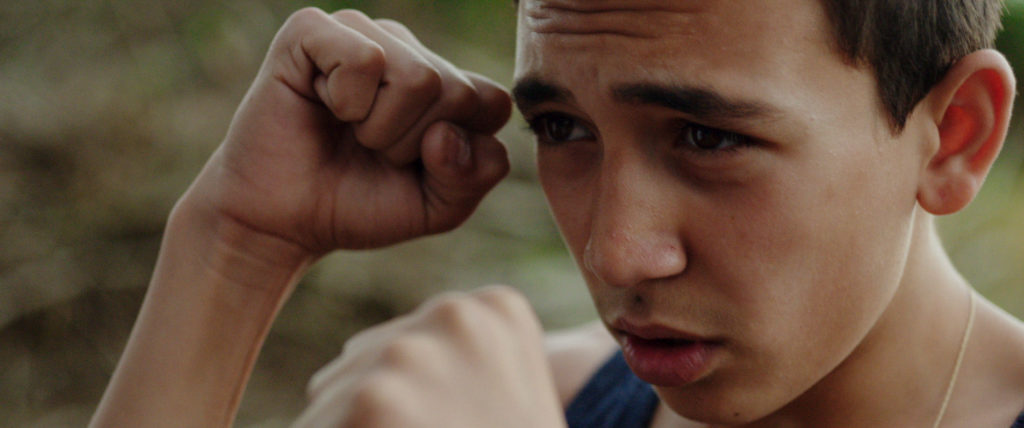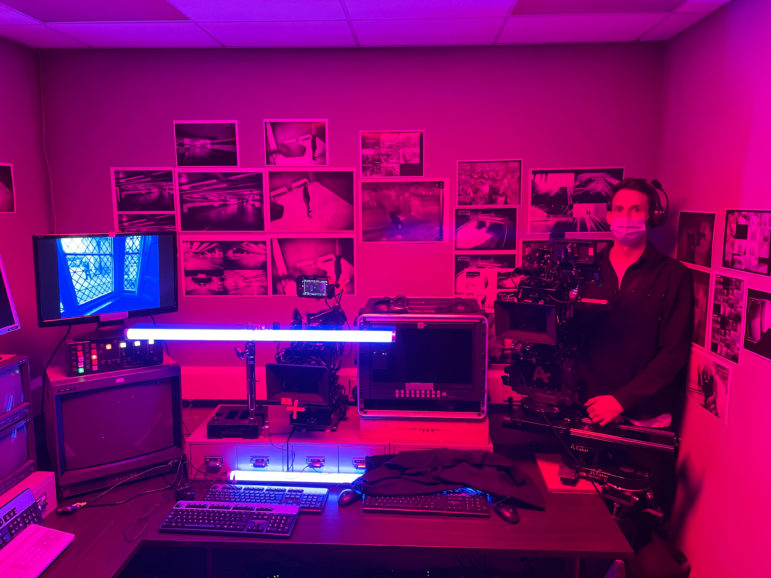STORY FIRST
Filmography so far:
My Name is Leon (TV single), Ragdoll (TV drama), Boxing Day (Feature), Save Me Too (TV drama, BAFTA winner), Benjamin (Feature), Love Me Not (Feature), Madonna and Basquiat (TV single), Patriot (Short), Out of Sight (Short)
When did you discover you wanted to be a cinematographer and what inspired you to follow this career path?
I happened upon operating when I was a teenager doing freerunning. It was a great accidental training ground, chasing fast moving human missiles with a camera. I fell in love with lighting years later on one of my first shorts, when a very generous gaffer, Greg King, showed me how you could create mood with light. I was hooked.


Where did you learn your craft?
The NFTS.
What are your favourite films, and what makes them stand out to you?
The Hunt – incredible writing and performance, and brilliantly understated photography.
Martha, Marcy, May, Marlene – the world building and tension.
Rear Window – suspense and commitment to the singular perspective.
Who in the film world inspires you?
Around 2010 when I was starting with a 5D, Gareth Edwards gained traction from a 48-hour short film. His journey made filmmaking feel possible. I love the work of Rob Hardy BSC, Natasha Braier ASC ADF, and Jody Lee Lipes ASC.


What’s the most useful advice you’ve received and from whom?
Brian Tufano’s advice was to always put story first, and your ego last. As we put it, ‘your ego is not your amigo’.
What advice would you give someone considering becoming a cinematographer?
Shoot, shoot, shoot. Make projects happen yourself, do the edits, and study light. The latter is a gift, because you can learn from and be inspired by it at any time, day or night.
What have been your greatest triumphs and disasters on set?
While shooting Patriot, we were almost struck by lightning and the location flooded, which was not ideal. But a real triumph came on Ragdoll when, after hours of planning, we were left with four minutes to go before wrap and a three-minute intricate oner that had evaded the can. With a volume of crew holding their breath by the monitor, the team, led by Emilio Schlappi on Steadicam, smashed the perfect shot to much applause.

What lights your fire outside of work?
My partner Helena is creative in so many ways and gives me endless energy. I also love playing mediocre tennis and below average chess.
What has been the biggest challenge in your career and how did you overcome it?
In 2017, I was hit by a van crossing the road, which threw things off course for a good year. Once or twice, I’ve ended up working with chaotic people, or bullies, which is difficult to navigate. I think it’s a slow process overcoming these things mentally. In the moment it helps to stay calm, try to keep your confidence up, and afterwards it always helps to talk about what happened.
What piece of kit could you not live without?
I’ve only been using it for a year, but I think I’d be missing a limb without my iPad now. Images, script notes, and scribbling floor plans all in one place is a game changer.

Which film would you love to have shot?
My favourite films tend to be thrillers, but…Forrest Gump is an incredible movie. It’s a love letter to a time and culture, through this unique character. It must have stretched a lot of different muscles to shoot as it shifts tone and period, while feeling totally cohesive. There’s a lot of hidden craft at play.
Which productions are you most proud to have lensed, and why?
Benjamin. The team was a joy, and we had a very collaborative director in Simon Amstell. I think the film hits a lot of different notes and resonates with people. Save Me Too, as it was my first series, a brilliant script, and I shot handheld for 15 weeks straight after dealing with quite the smorgasbord of injuries.
What’s the best and worst thing about your job?
Best: Creative fulfilment, variety, and working with filmmakers willing to take risks. It’s also lovely being able to give back to aspiring DPs, as others have been so generous with me.
Worst: The pressure of work can be a lot, and balancing your social life is tough.

How would you best describe your approach to cinematography?
Considered and sensitive. I try to understand what’s driving the story and put performance first as I work. I’m not that interested in leaving my fingerprint on something, or just making a beautiful image. What’s satisfying is getting the alchemy right in the room and finding the tone across a piece.
What are your aspirations for the future?
Films are my favourite. I’d love to shoot a great thriller, but the main thing for me is to enjoy the process and make something that stays with people.
What do you think are the industry’s biggest challenges?
Fairness and kindness. In who gets invited to the table, in how they are treated, and in the hours and conditions in which they work. Those things have to improve. Long hours six-day weeks are not healthy or sustainable. Everyone who wants to work in this industry should feel it’s accessible and be nurtured. Let’s celebrate diversity of race, gender, sexual orientation, and background on both sides of the lens.












